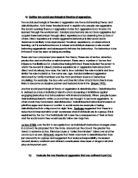Another social psychological theory of aggression is deindividuation. Deindividuation is defined as a loss of individual identity and a loosening of inhibitions against engaging behaviour that is inconsistent with internal standards. When people loosen their individual identity within a crowd they are thought to be more aggressive, in other words they have been deindividuated. Deindividuated behaviour is based on primitive urges and does not confirm to social normsAn example of being deindividuated is in a big crowd at night time. Festinger suggested that there is a reduction in inner restraints or self awareness when individuals are in a group. This is explained by the fact that individuals fail to see the consequences of their actions and the social norms they would usually follow are forgotten.
Le Bon (1985) was the first to recognise how an individual’s behaviour changes when in a crowd. He proposed that the more anonymous the crowd, the greater the threat of extreme action. This is because a “collective mindset” takes over and the crowd acts as one. Zimbardo argues that there was more to deindividuation than just anonymity in a group and suggested that reduced responsibility, increased arousal, sensory overload and altered consciousness because of drugs or alcohol play an important part.
b) Evaluate the two theories of aggression that you outlined in part (a)
The most famous studies on the Social Learning Theory were carried out by Bandura in the 1960’s. There were a number of variations to the studies. One study to illustrate the Social Leaning Theory was carried out in 1961. A total of thirty six boys and thirty six girls aged between three and five years were used as participants. There were two conditions in the experiment: an aggressive condition and a non-aggressive condition. In the non-aggressive condition children played individually in a room and then watched an adult “model” play quietly with toys. In the aggressive condition the children watched the model show aggressive behaviour towards a Bobo doll. Aggressive behaviour included punching, hitting with a mallet and shouting. The children were then taken into a room with a number of toys including a Bobo doll and mallet along with other toys such as crayons and dolls. The children from the aggressive condition showed more aggressive behaviour towards the Bobo doll than children from the non-aggressive condition. This suggests that the observation of the behaviour of others does lead to imitative learning.
The Social Learning Theory has numerous implications for classroom use. Discussing with a child the implications of aggressive behaviour in terms of consequences and non-aggressive sociable behaviour in terms of rewards can be effective in increasing appropriate behaviour. The Social Learning Theory has been applied to the development of psychological disorders and therapies associated with these disorders.
A criticism of the Social Learning Theory is that it ignores biological factors and the differences between individuals because of genetic, brain and learning factor. It ignores evidence which may suggest a biological or genetic component to human aggression (Miles and Carey (1997). The biological approach suggests hormones may take a role in aggression. PMS has been shown to be a reason for aggression, Flannagan, (2000) and the male hormone testosterone has also been shown to play a part, Tremblay et al, (1998). The theory also fails to explain gender differences in aggression. Research has shown males to be more aggressive than females. The Bobo doll studies carried out by Bandura showed that children were more likely to imitate a male “model” showing aggression, suggesting that physical aggression is typically seen as a male sex-appropriate behaviour. Yet the Social Learning Theory fails to explain why.
There have been several research studies which support the deindividuation theory. Perhaps the most popular is the Stanford Prison experiment carried out by Zimbardo et al (1973). In this study guards lost their sense of identity and acted as a group. They gradually lost the sense of what was right on an individual level, this suggests deindividuation. The individuals took on a role within the group and let the rest of the group guide their behaviour. The deindividuation led to increased brutality and a reduction in social conscience. This experiment had high ecological validity as both the environment and the behaviour were realistic. The findings of the study can be applied to real life situations in prisons. There were also realistic measures of aggression as both verbal and physical aggression was measured. However this study has been raised ethical concerns. Even Zimbardo himself acknowledged that the study had been unethical in terms of protection from harm and lack of informed consent.
There are also real life situations which support the deindividuation theory. Mullen (1986) analysed newspaper reports of lynch-mob violence in the United States. He found the large the mob, the greater the level and duration of violence. The deindividuation theory does not explain certain situations such as in an emergency or disaster when a crowd comes together to help. The theory is also a reductionist as it does not take into account biological factors. It does not take into account personality characteristics or other biological influences such as hormones.








